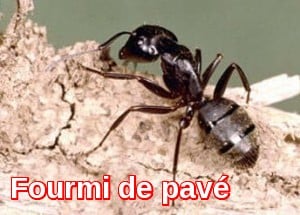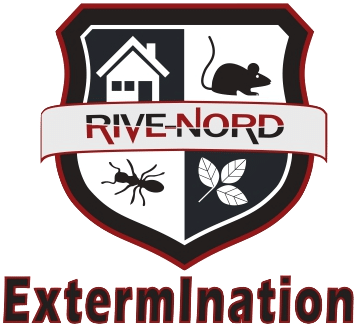Pavement ant exterminator

Pavement ant
Tetramorium caespitum
Description of the pavement ant
Here is a brief description of the pavement ant:
- Pedicel with 2 segments.
- Size from 2.4 to 4 millimeters.
- Brown-black coloration with black abdomen and paler legs.
- Inner surface of head without beard (long hair)
- Head and thorax longitudinally striated.
- Posterior part of the thorax with two spines.
Preferred habitat
- The pavement ant’s nest is usually located outdoors under rocks, along the edges of sidewalks, around foundations or in cracks in paving stones, especially near the lawn.
- The nest is sometimes located inside dwellings, especially in winter, in the basement (preferably cement cellars), near radiators, furnaces and any other sources of hot air.
- Occasionally, the pavement ant can nest in walls, under the floor and in the insulation system.
- It frequently wanders the kitchen and pantry looking for food.
Biology
- The colony is divided into three castes: the males, the queen and the numerous workers, which can number several hundred to several thousand insects.
- Winged insects (male and female) emerge in the spring. They will disperse, mate and the females (which will become the future queens) will found a new colony, either alone or with a few workers.
- The nest consists first of all of four chambers, in which the queen will lay her eggs. The larvae will emerge after four days. Their development takes two weeks, after which they will pupate.
- The pupae will hatch one to two months later, in late summer or early fall. The nest will expand horizontally. It consists of long and narrow galleries extending just below the surface, with small holes, often closed with grains of earth, communicating with the ambient air.
- The nest may be surmounted by either a dome or a crater.
- The workers are very courageous, aggressive, ferocious, robust, their bodies being very hard, their gait being quite fast, following each other in single file. When in danger, they fold their legs and antennae against their body.
- The second generation appears in March (as an adult), the third generation and sexual insects appear in May.
- The pavement ant is primarily a carnivore, preferring meat and insects. It will also consume sugar in the form of flower nectar.
- When two colonies of pavement ants overlap too much in their territory, it is war between the two colonies until the destruction or the surrender of one of the colonies.
Economic impacts
- Imported from Europe about 35 years ago to Quebec, it is today the most commonly encountered ant in extermination.
- This ant invades homes, mainly for warmth and for food in the pantry.
- It can ravage eggplants and strawberry fields. It attacks the tuber of the potato as well as the roots of cabbage, carrots and other plants.
- The pavement ant can bite and sting.
Pavement Ant Control
It is important to correctly identify the species and discover the nest(s) present inside or outside dwellings. The nest is usually quite easy to locate, as it is never located deep inside structures.
It is important to eliminate all nests inside and outside the building. Quickly contact our team of pavement ant extermination experts now.

